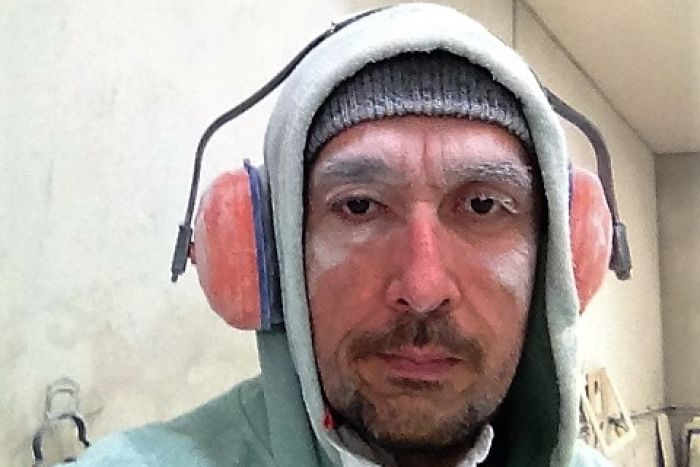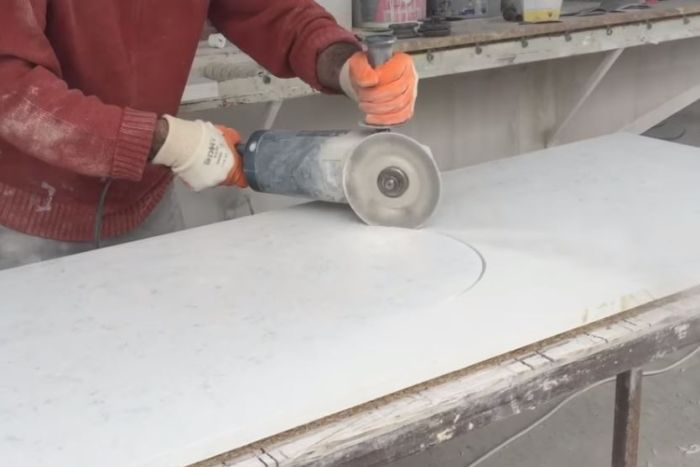Doctors are worried Australia is facing the worst occupational lung disease crisis since the peak of the asbestos disaster.
Stonemasons who cut engineered stone into a popular type of kitchen benchtop are contracting accelerated silicosis at alarming levels, after being exposed to unsafe levels of silica dust.
Last month the Queensland Government issued an urgent warning after 22 silicosis claims were lodged with WorkCover, including for six people who were diagnosed as terminally ill.
Brisbane-based senior occupational physician Dr Graeme Edwards has been involved in the health screening of the workforce and predicts there will be another dramatic spike in cases.
He said almost one in three workers tested so far in Queensland showed signs of silicosis.
"I'm expecting another 300 cases in Queensland by December alone," he told 7.30.
"It's horrendous, it's alarming. Fifty per cent of those are going to have progressive massive fibrosis (severe lung scarring)."
"The reason why it's a public emergency is because the system in Australia currently can only can accommodate about 200 lung transplants a year.
"We're going to be adding another 130 ... who will be lining up for lung transplants in the next three to five years."
An investigation by 7.30 has discovered silicosis cases amongst stonemasons in New South Wales, Victoria and the ACT.
In the past three financial years in Victoria there have been 16 silicosis claims by stonemasons, and in NSW there were 23 total silicosis claims, some by stonemasons.
Dust made worker look like a 'snowman'

Melbourne man Tahir Ozkul, 46, has accelerated silicosis.
For years he worked in a small factory where all he had was a paper mask, which failed to protect him from the dust created as he cut kitchen bench tops.
Engineered stone can contain up to 90 per cent silica, much higher than the content in granite or marble.
After a day at work he would be covered in dust and said he looked like a "snowman".
Mr Ozkul struggles to walk more than 20 metres unassisted, needs oxygen to breathe, and finds it hard to complete basic daily tasks like doing up his shoelaces.
"I can't do normal activity like walk, I can't go somewhere easily, I have to carry all the time my oxygen," he told 7.30.
"The pain, the short breath is very bad, I feel very uncomfortable."
This week Mr Ozkul had a lung transplant and is recovering in a Melbourne hospital.
Canberra man Frank Scott, another former stonemason, also has silicosis.
He needs oxygen 16 hours a day and struggles with physical tasks.
Mr Scott has been told he could need a lung transplant but is trying to avoid one for now.
"It's a shocking disease," he told 7.30.
"It's going to stop me kicking the ball around with my grandson and I think that's the main thing that hurts the most."
Mr Scott sometimes engaged in a practice known as dry cutting, which has been banned in Queensland due to the dangerous level of dust it releases.
He wants the rest of the country to ban the practice and enforce wet processing, where dust is suppressed by using water on the engineered stone.
"You don't want more people getting sick and getting ill in the future," he said.
'We have forgotten the lessons' from asbestos

There are concerns there could be thousands more stonemasons across the country who have the early signs of silicosis but don't know it, because they haven't been medically tested and show little to no symptoms.
Melbourne-based respiratory physician and spokesperson for the Thoracic Society of Australia and New Zealand, Dr Ryan Hoy, believes it is a public health crisis.
"I've seen more and more patients, about eight patients in the last 12 months," he told 7.30.
"That's really the tip of the iceberg. Those workers have presented with shortness of breath and symptoms of silicosis.
"What we're really worried about is those who have the disease but don't yet know they have the disease present."
The Thoracic Society has joined with another powerful medical body, the Royal Australasian College of Physicians, to call for urgent action.
They want respiratory health assessments of all past and present workers, independent monitoring of dust levels, stronger enforcement of regulations and an immediate ban on dry cutting.
"This is the largest occupational lung crisis we've seen since the peak of asbestos use in the 1960s and the 1970s," Dr Hoy said."
"We really have forgotten the lessons from that terrible time in our history with asbestos use."
Dr Hoy is calling for silicosis to become a notifiable disease, which would mean health authorities must be told about new cases.
"Certainly the Thoracic Society of Australia and New Zealand and other organisations would very much like to see silicosis being reportable," he said.
"That way when a case is being identified there can be a thorough investigation as to why that disease has occurred and to protect other workers at that workplace too."
The Federal Government told 7.30 that Safe Work Australia is "already working with the states and territories to progress initiatives to address exposure to respirable crystalline silica in the workplace".
A draft report of Safe Work Australia's review will be released by the end of 2018.



